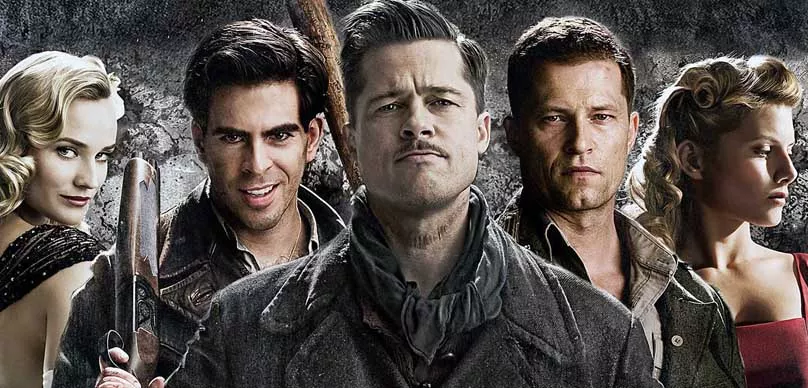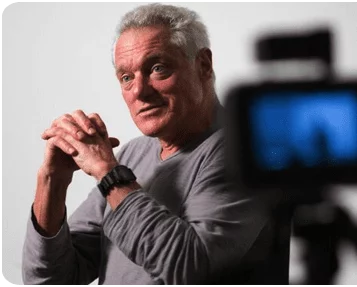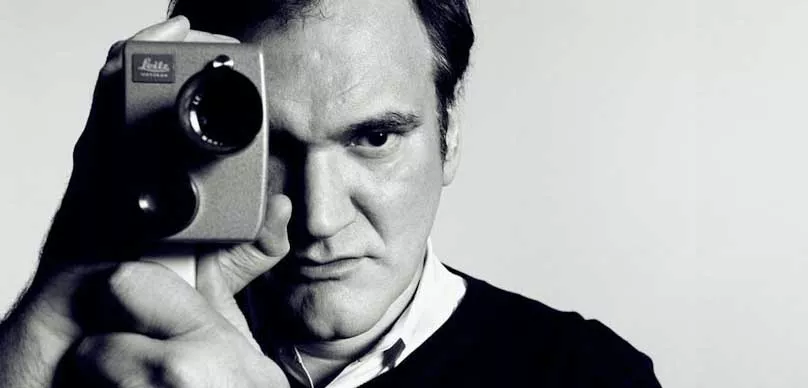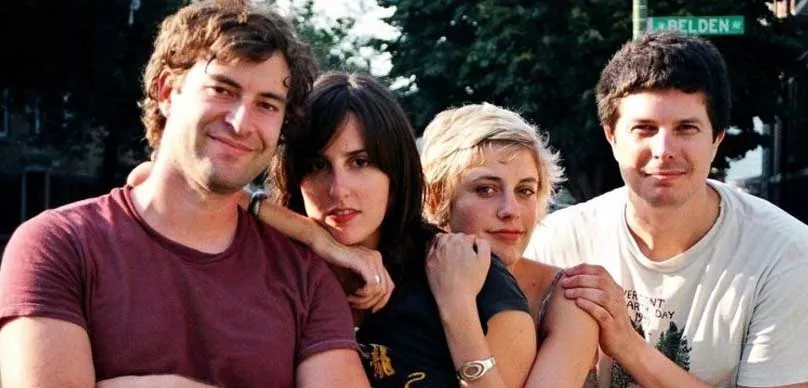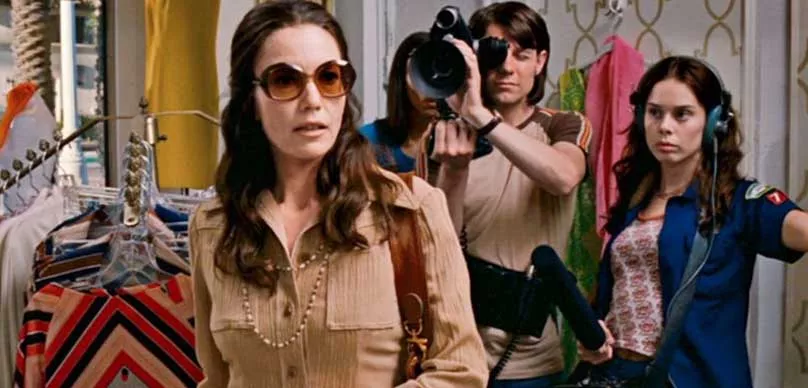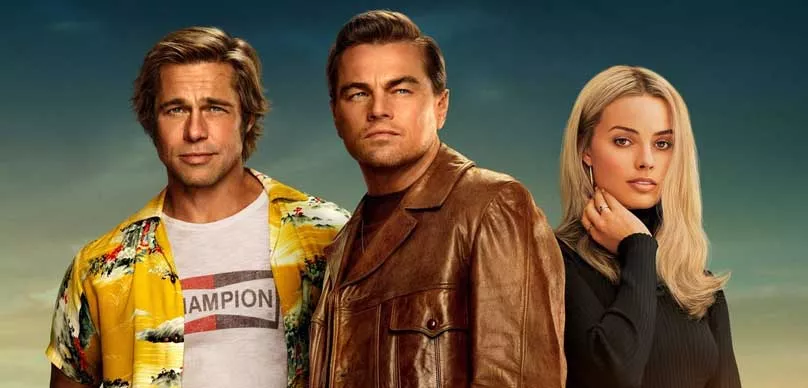Director Quentin Tarantino’s seventh feature film, 2009’s INGLOURIOUS BASTERDS, is a very personal film for me, in that various facets of its existence coincided with my own at the time. I had moved to Los Angeles in the summer of 2008, and my first job was as an intern floater at Lionsgate Entertainment. During this period, I was assigned to cover reception for weeks at a time, where I developed a strong rapport with the co-receptionist, who has gone on to a successful writing career and has also become a very dear friend and writing partner. He was always getting his grubby little mitts on high-profile scripts that were typically shielded from public consumption, and one day he slipped me the leaked script for Tarantino’s INGLOURIOUS BASTERDS (I’ll never forget the title as it looked on the cover page, scrawled haphazardly by Tarantino’s own hand).
You can read all of Quentin Tarantino’s Screenplays here.
It was the first time that I got to see this angle of Tarantino’s work—the script itself. The man had always been hailed as a visionary screenwriter, beginning from his early days when he famously sold the scripts to TRUE ROMANCE and NATURAL BORN KILLERS to Tony Scott and Oliver Stone, respectively. His talent for dialogue had always been well-known, but this was the first time I got to see it on the page with my own eyes. It was like having intimate, unrestricted access to Tarantino’s brainwaves, undiluted by the restrictions of production or budget.
My personal connection to INGLORIOUS BASTERDS continued in the wake of the film’s release the next summer. A few days before, I was killing time browsing the sea of DVDs in Hollywood’s Amoeba Records, oblivious to the surging crowd that was buzzing in the hangar-like space below me. Then that familiar, manic voice boomed over the PA system. Tarantino took the stage of the store’s little performance space and began whipping the crowd into a frenzy with his infectious enthusiasm. I couldn’t believe it—Tarantino had such a formative effect on my filmmaking development and here I was looking at the man himself, in the flesh. He was just like how he is in interviews, all antsy and motor-mouthin’, even a little sweaty. I’ve seen very few great directors in person (the others being Gus Van Sant and Ridley Scott), so this was an electrifying moment for me. Like being nailed by a bolt of lightning.
There’s a third connection that I didn’t even realize I had until today. The film’s centerpiece sequence, the massacre of Hitler and his top lieutenants, takes place in a French theatre that Tarantino and his production designer, David Wasco, modeled after the Vista in Los Angeles’ Silverlake neighborhood. The Vista is my favorite theatre in all of LA, which is saying something for a city that boasts veritable film cathedrals like the Arclite and the Cinerama Dome. The Vista is a small, Art Deco one-screen theatre on an unassuming block in Silverlake, but its marquee signage and the auditorium’s hokey Egyptian design theme are anything but. It’s an endlessly charming cultural landmark that I love seeing movies in any chance I get. The $6 matinee price doesn’t hurt either.
Tarantino had been gestating the concept for INGLOURIOUS BASTERDS for nearly a decade prior to its release, scratching out and scuttling numerous drafts in the pursuit of perfection. He came to see the film as his magnum opus, and he felt that every word had to be perfect. After the disappointment of 2007’s DEATH PROOF, Tarantino felt that it was an appropriate time to seriously tackle his long-in-development WW2 film and return to cinemas with his guns blazing.
INGLOURIOUS BASTERDS was initially conceived as a men-on-a-mission film, similar to THE DIRTY DOZEN (1967) or its own namesake, Enzo Castellari’s THE INGLORIOUS BASTARDS (1978). Tarantino mainstay Michael Madsen was supposed to star as a character named Babe Buchinsky, and Adam Sandler was intended to play a role that made it into the finished film: Sgt. Donny Donowitz, a role eventually filled by Tarantino’s filmmaking colleague Eli Roth. As it did with his KILL BILL saga before it, Tarantino’s script inevitably got away from him. It sprawled in scope and size, and before he knew it, Tarantino’s small band of Nazi scalpers found themselves as supporting characters in a larger ensemble piece about the conspiracy to kill Hitler.
Tarantino’s finished film follows two separate threads that eventually combine. The first is the story of the Basterds, headed by a tough SOB named Lt. Aldo Raine (Brad Pitt) who charges his men with a personal debt to him—one that can only be repaid in 100 Nazi scalps. Meanwhile, a young Jewish girl named Shoshanna hides in plain sight under an assumed name and occupation as a French theatre owner after escaping the massacre of her family at the hands of the ruthless Jew Hunter, Col. Hans Landa (Christoph Waltz). When events conspire to hold the premiere of a prestigious Nazi propaganda film at her theatre, she hatches a plot to burn the theatre down with the Nazis inside. The Basterds learn of this premiere separately, hatching their own plot when they learn from their German film star-turned-double agent Bridget Von Hammersmark (Diane Kruger) that Hitler and his top officers will be in attendance. What follows will change the course of history as we know it.
For a film about World War 2, INGLOURIOUS BASTERDS is infamously short on action, choosing instead to create a handful of setpieces featuring the actors sitting around a table and talking. Naturally, the performances have to be compelling, and Tarantino coaxes career-best performances out of every single one of his cast members. Even though he gets top billing on the poster, Pitt is simply one cog in Tarantino’s complex machine of a plot. The widely recognizable film star crafts perhaps his most outlandish persona yet as the Tennessee-bred Lt. Aldo Raine, better known by his enemies as The Apache. Pitt plays the character as a charmingly vengeful force of nature—a tough, gruff proto-American with a mysterious neck scar that’s never explained but alludes to the magnitude of his resilience and grit. He’s a perfect avatar to convey Tarantino’s cartoonish take on history.
I initially found Tarantino’s casting of the remaining Basterds to be surprising, given the earlier rumblings about Madsen and Sandler. In retrospect, the casting is inspired and fits the tone very well. Eli Roth had left a bad taste in my mouth after seeing his film HOSTEL(2005), but he won me back over after performing as the Bear Jew, Sgt. Donny Donowitz. He assumes a boarish demeanor and a heavy Masshole accent as he bashes in Nazi brains with a bat bearing the names of Jewish friends and family back home. He’s not the best actor in the world, but he has an unexpected degree of talent in this arena that serves the film very well.
THE OFFICE’s BJ Novack gets his first high-profile film role here as Pvt. Smithsen, as does DEATH PROOF co-star Omar Doom as Pvt. Omar Ulmer. Finally there’s Til Schweiger as the stoic Nazi hunter Sgt. Hugo Stiglitz. In addition to getting his own grindhouse-esque backstory sequence, Schweiger gets some of the film’s best lines, like “say goodbye to your Nazi balls”.
INGLOURIOUS BASTERDS also features some fierce females, in the form of Diane Kruger and Melanie Laurent. Kruger uses her natural glamor to striking degree as the elegant German film star, Diane Von Hammersmark. In such a testosterone-laden film, she’s a breath of fresh air—but make no mistake, she’s just as tough as any Basterd, if not more so. She plays a crucial role as the Basterds’ inside woman, and her participation helps pave the way for Hitler’s downfall and the end of World War 2 (at least in Tarantino’s timeline).
Equally as determined is European revelation Melanie Laurent, who is heartbreaking as the vulnerable Shoshanna. After suffering the horror of having her family massacred by Nazis, she channels her trauma into a strength that helps bring down the entire Nazi regime. It’s a career-making performance, and I hope to see her utilized in more American films down the line. Shoshanna is a perfect example of Tarantino’s nuanced understanding of the fairer sex and his penchant for empowering them.
Less fierce is Julie Dreyfus, who serves in a similar capacity to her Sofie Fatale role in KILL BILL VOLUME 1 (2003). Here, she plays Francesa Mondino, Joseph Goebbels’ French interpreter and sexual plaything. It’s really more of a small cameo, but her reprisal of the glamorous assistant/interpreter/confidante archetype points to running themes and in-jokes across Tarantino’s entire body of work.
Irish actor Michael Fassbender finds in INGLOURIOUS BASTERDS his mainstream breakout role as British film critic and serviceman, Lt. Archie Hicox. He only appears in one chapter, but, Christ….what an appearance. Fassbender effortlessly assumes the droll, aristocratic nature of his character. He has a subtle confidence that somehow makes him even more badass than his Basterd colleagues. There’s a moment in a tense Mexican standoff at a basement bar crawling with Nazis, whereby Fassbender has a pistol pointed directly at him under the table. Sensing his impending demise, he calmly takes a shot of whiskey and drops his cover as a fellow Nazi officer by stating: “since it appears I’ll be rapping at death’s door very shortly, I hope you don’t mind that I go out speaking the King’s.” Ugh, so badass. So fucking classy. In this single sequence, Fassbender assured his stardom in addition to capturing the lusty hearts of women (and men) the world over.
Suprisingly, Mike Myers makes a cameo appearance as Hicox’s commanding officer, General Fanny. Prior to seeing the film for the first time, I was aware that Myers was in the film. However, I strained to find him until I suddenly realized that the balding British general giving Fassbender his orders was in fact, Austin Powers himself. Myers serves up a positively chameleon-esque performance that makes great use of his comedic talents to subtle, engaging effect.
And then there’s INGLOURIOUS BASTERD’s big revelation. The man that anybody who saw the film could not stop raving about. The man whose performance was so striking that it launched him from European obscurity to American Oscar-winner overnight. Yes, I’m talking about Christoph Waltz, the seasoned character actor who until recently was completely unknown to our shores. As the chief antagonist Col. Hans Landa, Waltz is positively electrifying. He’s at once both charming and cold-blooded, concealing a very deadly ferocity with a dandy, effete demeanor. He goes against every single villain expectation in the book, even going so far as to defect to the Allied side when he realizes the Nazis can’t win. Waltz is endlessly entertaining in the role, and it’s baffling to think that Tarantino once wanted Leonardo DiCaprio in the role. Literally no one else could have played this part as well as Waltz has. His performance single-handedly elevates this film from a great film to cinematic history.
Tarantino once again utilizes the talents of cinematographer Robert Richardson to render the somber French locales in vivid, bright color. They style the film as a modern-day spaghetti western, albeit set in World War 2. The 2.35:1 aspect ratio allows for dramatic, expansive compositions, and the high-key lighting scheme allows for a deep contrast that gives the film a palpable weight. INGLOURIOUS BASTERDS boasts an autumnal look, with desaturated greens and wet, drab stone-greys that allow for the bright red of blood and Nazi flags to really pop. Camera-wise, INGLOURIOUS BASTERDS is Tarantino’s most low-key work yet. He chooses to keep the camera locked-off for a vast majority of the film, employing the strategic use of dolly and crane shots only when it serves a strong purpose. As Tarantino’s first period piece, production designer David Wasco faithfully creates authentic costumes and sets for the cast members to inhabit.
Tarantino initially wanted legendary composer Ennio Morricone to score the film, owing mainly to the fact thatINGLOURIOUS BASTERDS took so much inspiration from spaghetti westerns. Unfortunately, Morricone was unable to commit, and Tarantino subsequently used selects from the maestro’s existing score work for his own purposes. He also includes a few cues that he previously utilized in his KILL BILL saga, which ties his self-contained universe closer together.
Tarantino has to be the first director in memory to use scores for existing movies as source tracks, almost as if they were pop music or rock and roll. To Tarantino, film music is rock and roll—there’s no difference. What it was initially created for or when it was created bears no difference to the story, only that it should strike to the core of whatever emotional truth Tarantino is trying to convey at any given moment. This is best exemplified in the use of an anachronistic David Bowie track during an introductory montage to the cinema-house massacre. In perpetuating this practice, Tarantino has given a huge gift to cinema; he has unshackled music from the context of its time and allowed for unparalleled levels of commentary and thematic expression.
INGLOURIOUS BASTERDS is an unconventional war film, in that it doesn’t concern itself with battle but with the thematic conceit of language. Right down to the misspelled title, Tarantino makes no bones about language as the driving force of the film. The majority of the film is in a language other than English, with several characters switching between languages as easily as you would slip out of a t-shirt and into a new one. Christoph Waltz flits from German, to Italian, to English and French without so much as a second thought, making his Hans Landa character a truly formidable foe in a world where language means the difference between life or death. Tarantino also plays the cultural linguistic divide for laughs, such as a truly hysterical moment where Brad Pitt’s American character must butcher the elegant musicality of Italian through his thick Southern drawl. And who can forget Waltz’s absolutely ridiculous delivery of “That’s a bingo!”?
Indeed, the film itself is structured like that perennial celebration of language: the novel. Tarantino’s use of book-like chapter designations has never been more appropriate and justified than it is here, whereby he eschews typical three-act film structure and bases his story around a handful of distinct, elongated set-pieces he deems as “chapters”. And just like a novel, Tarantino isn’t afraid to dwell on the minutiae of a single moment. The longest scenes in the film—the opening in the French farmhouse and the basement tavern rendezvous with Hammersmark—go on for almost half an hour each, dragging out the suspense to an almost unbearable degree until it is released in an explosion of blood and violence. For most directors, this approach would be highly ill-advised, but Tarantino’s preternatural talent for engaging dialogue keeps his audience dangling on every well-chosen word.
Tarantino’s signature structural trademarks are all present and accounted for—the yellow title font, the creative profanity, abrupt music drops, a victim’s POV shot looking up at his aggressors, elaborate tracking shots, the Mexican standoff, etc. However, here they mark a profound change in maturity; that is to say, there’s a refined, worldly sophistication to his techniques where they were once vulgar, coarse, and undisciplined.
It’s fitting that Tarantino’s story uses a movie theatre as an important element, so much so that it plays a hand in ending World War 2. The film references in his previous films have all built up to this, wherein a movie premiere becomes a watershed moment in world history and turns a generation of Americans into film buffs (albeit, only within Tarantino’s self-contained universe). He uses Shoshanna’s theatre as the climax’s venue, showing it off in an elaborately elegant tracking shot similar to how he presented the geography of KILL BILL VOLUME 1’s House of Blue Leaves set. Whereas the latter sequence tends to come off as showboat-y, here Tarantino exercises a degree of restraint that builds tension and anticipation by expertly setting up the dominos for an explosive finale.
Despite being consistently hailed as an auteur, Tarantino has always relied on the talents of an elite pool of collaborators. The aforementioned Richardson and Wasco have played an integral role in bringing Tarantino’s vision to the screen, as have regular producing partners Lawrence Bender and the Weinstein brothers. Past Tarantino performers like Harvey Keitel and Samuel L. Jackson appear in voice cameos as an OSS Commander and an omniscient narrator explaining nitrate film’s flammability, respectively. Tarantino also finds another use for Eli Roth’s talents by commissioning him to direct NATION’S PRIDE, the film-within-a-film whose premiere the Nazis are celebrating.
Throughout his career, Tarantino has shown considerable respect towards his collaborators. There are stories from the set of INGLOURIOUS BASTERDS about how he’d hold screenings for his crew featuring the movies by their co-stars and fellow craftsmen. Not many directors show such reverence towards the people they work with; it’s no wonder that Tarantino is so highly regarded amongst actors and below-the-line talent alike.
Of course, I must mention Tarantino’s biggest collaborator, the superbly-talented Sally Menke. Out of all the people who could lay claim to helping Tarantino become the director he is today, Menke’s contributions put her head and shoulders above every single one. She is the shaper of Tarantino’s vision, finding the music in his dynamic compositions and harnessing the raw energy of his direction into a coherent experience. The flawlessly-edited INGLOURIOUS BASTERDS marks the high point, the culmination of their work together. Unfortunately, it also marks the last time they will ever work together. Sadly, Menke passed away in 2010 as she was hiking in Los Angeles’ Griffith Park, and with her death Tarantino lost his co-author and his platonic partner. It remains to be seen how this will play out in Tarantino’s work going forward, but the success of 2012’s DJANGO UNCHAINED is promising.
INGLOURIOUS BASTERDS was an unprecedented success for Tarantino, besting even 1994’s PULP FICTION. Until it was unseated by DJANGO UNCHAINED, INGLOURIOUS BASTERDS was Tarantino’s highest-grossing film and still remains as his best-reviewed. True to form, the film was met with considerable controversy upon its release. Some were uncertain whether the concept of Jews aggressively pursuing revenge on the Nazis was in poor taste or not, or if it was respectful to survivors of the Holocaust. Still others were frustrated by Tarantino’s blatant historical revisionism, which takes the apocryphal tack of gunning down Hitler in a gleeful hail of bullets during the theatre inferno sequence (as opposed to shooting himself in a bunker like he did in real life). Personally, it’s an act of wish-fulfillment that’s firmly on-tone with the story that precedes it. By taking such a cartoonish attitude towards his aesthetic, Tarantino grants himself the license to alter history as he sees fit, making for a much more cathartic ending to World War 2 than we actually got.
As far as Tarantino’s career development goes, INGLOURIOUS BASTERDS marks the beginning of a new phase for the controversial auteur. If DEATH PROOF saw the end of his Tex-Mex/grindhouse phase, then this film begins something much more prestigious. Indeed, INGLOURIOUS BASTERDS is the closest that Tarantino has ever come to Oscar respectability in the Academy’s eyes (PULP FICTION’s screenwriting win notwithstanding). The reverence bestowed upon his follow-up, DJANGO UNCHAINED, only reinforces the notion that he is in a prestige phase. Perhaps it’s only appropriate, given that Tarantino is now firmly in middle-age and has gone on record to state that he would be happy only having ten features to his name (INGLOURIOUS BASTERDS is the seventh). Faced with the possibility of his career winding down, it’s only natural that Tarantino would be concerned with his legacy.
The film’s final moment has Pitt carving a swastika into the forehead of a screaming Waltz. Admiring his handiwork, he muses: “you know what, I think this just might be my masterpiece”. All cheekiness aside, INGLOURIOUS BASTERDS might very well be just that: Tarantino’s masterpiece.
Sponsored by: Special.tv – Stream Independent
Author Cameron Beyl is the creator of The Directors Series and an award-winning filmmaker of narrative features, shorts, and music videos. His work has screened at numerous film festivals and museums, in addition to being featured on tastemaking online media platforms like Vice Creators Project, Slate, Popular Mechanics, and Indiewire.
THE DIRECTORS SERIES is an educational collection of video and text essays by filmmaker Cameron Beyl exploring the works of contemporary and classic film directors.

